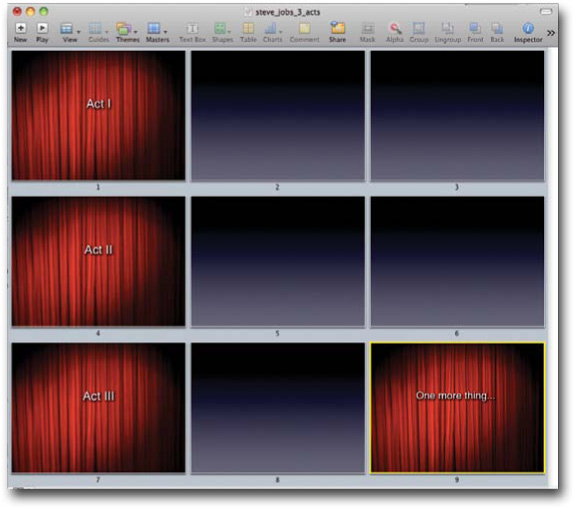Presentation Zen: Simple Ideas on Presentation Design and Delivery, 2nd Edition (Ira Katz's Library) (32 page)
Authors: Garr Reynolds

Getting and keeping an audience’s attention can be a tricky thing. Generally, audience’s want you to succeed, but they will still only give you one or two minutes of a “honeymoon period” for you to make a good impression. Even famous, well-established presenters, including celebrities, will only get about a minute before audiences grow tired of a presenter’s inability to make a good impression and grab their attention. There is no excuse for a weak start. If your technology lets you down just as your presentation starts, you cannot stop. As they say in show business: “The show must go on.” People form impressions of you and the presentation in the first few moments. You never want those first few moments to be a memory of you trying to get the technology to work.
Do not apologize or imply that you have not prepared enough for a given audience. It may be true, and your apology may be sincere and honest (rather than just being an excuse), but it never comes across well to an audience. The audience does not need to know that we have not prepared as much as we would have liked, so why mention it and get it in their head? You actually may be prepared enough and doing well, but now the audiences is saying to themselves “Man, he’s right—he didn’t prepare enough.” The same goes for telling people you’re nervous. “You didn’t look nervous, but now that you mention it....”
A confession that you are nervous may seem honest and transparent, but it is too self-focused at a time when you are supposed to be focused on the audience and their needs and their feelings. An admission about being nervous is not said to make the audience feel better, only to make yourself feel better. If you admit that you are nervous, you may actually feel better since labeling and acknowledging your emotion is better than suppressing it. This is why people
say it—because saying it out loud does make you feel a little better. However, the presentation is about the audience, and telling them how nervous you are does not serve their interest. Acknowledge to yourself that you are nervous. Being nervous is normal and saying it to yourself will help you feel better. But you do not need to share this information with the audience.
Do not start with an agenda slide. After you have made an initial connection with the audience, however, it’s a good idea to give people an idea of where you are going during your time. Usually you can do this verbally in just a few seconds. But, if you have a lot of material, you may want to show the audience how your talk is structured and then remind them along the way where you are in the presentation. In a 2007 Macworld keynote presentation, Steve Jobs did this by breaking his presentation into three “Acts” and displaying the number of the act before each of his three sections.

To make a connection you cannot be timid—you must project yourself. There are three things to consider when evaluating your ability to project yourself to an audience aside from the content of the talk: The way you look, the way you move, and the way you sound. The audience members, whether they know it or not, are judging you and your message based on these elements. All these factors influence your ability to make a strong connection.
How you dress matters. A rule of thumb is to dress at least a little more formally than your audience. It’s important to dress appropriate to the organization and the occasion, of course, but it’s better to be a bit overdressed than underdressed. You want to project an image of professionalism, but you do not want to seem out of touch with your audience either. In Silicon Valley, for example, the dress code can be quite casual and even a well-groomed person in jeans with a quality shirt and a good pair of shoes may look professional. (When we occasionally saw people in business suits on the Apple campus, we could tell they were from out of town.) In Tokyo, both men and women cannot go wrong with a dark business suit virtually anywhere. You can always bring your formality down a notch by removing your jacket, removing the tie, and rolling up the sleeves, but it’s difficult to dress up a look that is too casual. To be safe, and to show respect for your audience, err on the side of dressing up.
If you can avoid it, do not stand in one place during the entire presentation. It’s far better to walk to different parts of the stage or room, which allows you to engage with more people. You should not, however, pace back and forth or wander around the area near the screen without purpose. This kind of movement is distracting and projects a nervous energy rather than a confident, open energy. When you walk from one area to another, do so slowly and while standing tall. Stop to make your point or tell a story, then move slowly to another part of the stage before stopping again to elaborate on a different point. When someone asks a question from the opposite side of the room, walk slowly in their direction, acknowledging their presence while listening and approaching their side of the room. So long as people can still hear you, it is
a good idea to walk into the audience from time to time—provided you have a purpose for doing so, such as answering a question during an activity that you assigned to the audience.
When you stand, do so with your feet comfortably but firmly planted about shoulder-width apart. You should not stand like a cowboy about ready to draw his guns, but neither should you stand with your legs together as if standing at attention. Standing at attention or with your legs crossed demonstrates a closed, defensive, or uncertain attitude. These positions, which are unnatural ways to stand when we are relaxed, make you a bit unstable and project weakness to others. About the only thing worse than standing on a stage with your legs crossed is doing so while leaning against the lectern. At best, it looks sloppy. At worst, it projects an image of weakness.
When we get nervous, most of us tend to speed up our movements, including hand gestures. If you want to project a more calm, relaxed, and natural image to the audience, remind yourself to slow everything down.
Even if you are projecting visuals behind you, there is no need to turn your head to look back. Even if you gesture toward the screen, stand so that your shoulders are facing in the direction of the audience. If you keep your shoulders pointed toward the front, you will naturally turn your head back toward the audience without thinking about it after you glance at the screen. Turning slightly and briefly toward the screen to point out a detail is acceptable. However, continually looking at the screen as a reminder of where you are is very distracting and unnecessary. Except in rare incidents, if you use a computer to project visuals, you can place the computer down low in front of you so there is little reason to turn around.

MIT’s Hiroshi Ishii faces the audience at TEDxTokyo. (Photo: TEDxTokyo/Andy McGovern.)
Related to the importance of facing the audience is establishing good eye contact. Maintaining natural eye contact with the audience is crucial, which is one of the reasons I advise against reading a script or relying on notes—it’s hard to look into people’s eyes when your eyes are looking down at notes. Your eye contact should appear natural, and you achieve this by looking at actual people in the room. If you instead gaze out at the back of the room or to a point on either side of the room, your audience will detect this at some level and the connection will be weakened.
If your audience is relatively small, say, under 50 or so, it may be possible to actually look everyone in the eye at some point during your talk as you move deliberately to different parts of the room. For larger audiences in a typical keynote-style presentation, it is still useful to pick out actual people to lock eyes with as you speak—even people who are sitting toward the back. By looking at one person, others near that person will feel as if you are looking at them as well. This is a technique that professional singers use when playing larger halls. It is important not to just glance at or scan general areas of a room but rather to briefly establish actual eye contact with people in different parts of the room.
It’s true that the best presentations seem more like good conversations, but there is a difference between speaking with two or three people over coffee and standing to present to an auditorium of 500 people after lunch. Your tone should be conversational, but your energy must be cranked up several notches. If you are enthusiastic, the energy will help project your voice. Mumbling is absolutely not permitted, and neither is shouting. Shouting is usually not sustainable and it’s very unpleasant for the audience. When you shout, the volume may go up but the richness of your voice, the peaks and valleys of your unique intonation, are lost. So stand tall, speak up, and articulate clearly, but be careful not to let your speaking evolve into shouting as you speak with energy and project your voice.
Should you use a mic? If your room is a regular-size classroom or conference room with space for only 10 to 30 people, then a mic may not be necessary. But in almost every other case, a microphone is a good idea. Remember, it is not about you, it is about them. Giving the audience even just a slight bump
in volume through the use of a microphone will make it easier for them to hear you. Many presenters, especially men, eschew a mic and decide to shout instead. It’s as if declining a microphone and choosing to shout is somehow more manly and assertive. But unless you are a head coach delivering an inspiring halftime speech for your football team, shouting is a very bad idea. You are not addressing your troops, remember, you are trying to present in a natural, conversational manner. The microphone, far from being a barrier to connection, can actually be a great enabler of intimacy as it allows you to project in your best and most engaging natural voice.
Only use a handheld mic, however, for very short speeches and announcements. A better option than a handheld mic is a wireless lavalier mic, also called a clip-on or lapel mic. The lavalier is good because it frees up a hand, which is especially important if your other hand is holding a remote control device. The downside of a lavalier is that if you turn your head to the side, some mics will not pick up your voice as well. Whenever possible, the best type of microphone to use is the headband or headset variety used for conferences such as TED. This type of wireless mic places the tiny tip of the mic just to the side of your mouth or your cheek and is virtually invisible to the audience. The advantage of this mic, besides eliminating the possibility of ruffling noises from your shirt, is that no matter how you move your head, the mic stays in the same position and always picks up your voice clearly.

Master game creator Tetsuya Mizuguchi speaking at TEDxTokyo 2011. The wireless headset mic picks up the voice best and allows for freedom of movement.
Communications guru Bert Decker urges speakers to avoid reading a speech whenever possible. In his book
You’ve Got to Be Believed to Be Heard,
Decker advises against reading speeches. “Reading is boring,” he says. “Worse, reading a speech makes the speaker look inauthentic and unenthusiastic.” This goes for reading slides as well. Many years ago the typical use of slideware involved people actually reading lines of text right from the slides behind them—and believe it or not, it still happens today. But don’t do it. Putting lots of text on a slide and then reading that text is a great way to alienate your audience and ruin any hope you have of making a connection.